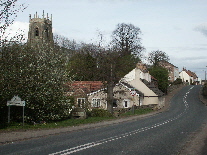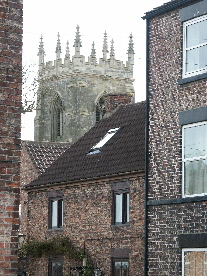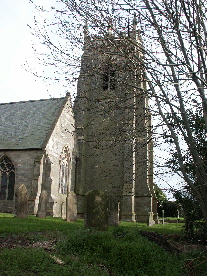|
|
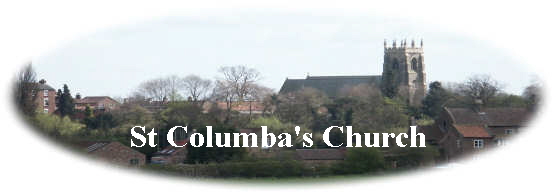 |
||||
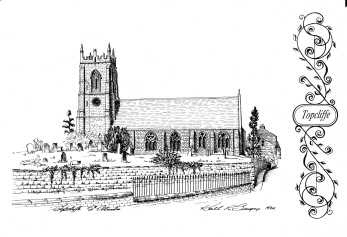 |
||||
|
The small village of Topcliffe is now a quiet place, with the bulk of passing traffic using the A168 to travel between the A1 and the north east. It is hard to imagine that this ancient settlement was once an important town, which staged one of the largest annual fairs in the north of England. The charter which allowed this fair, and a weekly market, was granted by Edward III in 1327. Maiden Bower an ancient fortification to the south of the village was used by the Percy family as the site of their manor house. They were the Norman lords of the manor, and rose to be one of the most important families in England. Shakespeare dramatised rebellion led by one of them, Henry Percy (“Hotspur”), in Henry IV part I. Hotspur was killed in action at Shrewsbury in 1403, and his body was brought home here for burial. The chapel at the east end of the north aisle still bears their name. The first church at Topcliffe was founded by St Aidan or one of the other disciples of St Columba around 650. Most buildings at this time were made of wood and thatched with reeds. It is likely that the building was destroyed when the Danes descended on Yorkshire in 794. Like many other places, we have very little additional information until the Doomsday survey. It is generally believed that the first stone church here was erected by the Percys (later Earls of Northumberland), the new Norman lords of the manor soon after 1066. The Domesday book mentions that the church had two priests. An early cross is still preserved in the porch of the church. We know very little about this building, but it is likely that as the lords of the manor improved their status they enlarged and embellished their church. There is evidence that there were at least four altars in the pre-reformation church at Topcliffe. The High Altar is a Jacobean table, which is said to have been removed from the church by the puritans in the time of Cromwell. At the Restoration it was retrieved from the Angel Inn and returned to its previous role. After the Restoration, the building continued to be modified and expanded. The building must have been considerably larger than it is now, as the old tower stood further to the west, shored up by strong buttresses. There were two aisles, as there are today, but the north aisle roof was a lean-to against the south aisle wall. Little of the old fabric remains, apart from the east window and the south wall of the chancel. The east window is of four lights with a four petal motif in the head, which is typical of the 14th century. It is hard for many of us to imagine a church without an organ, but in many churches music was provided by a group of musicians playing fiddles, bassoons, and serpents. They sat in a gallery at the west end of the church. By Georgian times, the church was full box pews, and the congregation turned towards the western gallery to join in the hymns and anthems. In the 1850s, the church was almost entirely rebuilt. The work was completed in 1855 at a total cost of £3,160. The new church was designed by George Andrews, who had designed railway stations for the companies owned by George Hudson, who lived at Baldersby Park from 1845 to 1853. He had earned himself the title ”Railway King”, but was more ambitious than honest, and when his empire collapsed the end was abrupt and complete. In the nave, there is a remarkable brass of Flemish workmanship 6’x3’, bearing full length effigies of Thomas de Topcliffe (1365), and his wife (1391). This is one of the best examples of this type of monumental brass in this part of England. It is a palimpsest, i.e. it is made up of fragments of other earlier brasses. In the Percy Chapel are memorials to the Robinsons, ancestors of the Marquis of Ripon. The family originated in York, and made a fortune in the Baltic trade. Sir William (1655-1736) built himself a fine Palladian house at Baldersby Park. He was for many years the MP for Northallerton, and was returned in eight successive Parliaments for the City of York. He was also High Sheriff of Yorkshire (1689), and Lord Mayor of York (1700). His wife, Mary, was the sister of John Aislabie, who created the landscape gardens at Studley Royal. The Robinsons grew in importance, one was Prime Minister for a brief time, and one was Viceroy of India. In the top of the East window of the Percy Chapel there are a few fragments of medieval glass. Skulls can be seen on some, and others appear to be fragments of a coat of arms. Most of the stained glass is Victorian, and was contributed by parishioners after the church was rebuilt. The east window tells the Easter story, starting with Mary anointing the feet of Jesus, and moving up to Christ in Majesty, with Mary, Moses, and the Archangel Michael below him. There are two windows on the south side of the chancel. One is in three panels , on the left is the annunciation (designed and signed by Sir Edward Burne-Jones, just after he left Oxford), in the centre are Mary and her cousin Elizabeth (designed by Michael Halliday, a pupil of Millais), and the panel on the right shows the holy family. The strident colours are typical of the Pre-Raphaelite Brotherhood. The other window in two panels, which is by Henry Holiday, continues the story of the holy family. One panel shows Joseph being warned of the massacre of the innocents, and the other shows the child Jesus in the Temple. The window in the nave shows John the Baptist, St. Columba (holding a model of the church on Iona), and St. Paulinas, who is said to have baptised 10,000 people in the river Swale near Helperby in 627. This event earned the river the name ”the Jordan of England”. The window is the work of Charles F. Kempe. The peacock feathers on the angel wings are typical of his work. The window in the vestry at the base of the tower is one of several items dedicated to the Hawkins family. Rev. Hawkins was the vicar here for 53 years, and his grave is in the churchyard. He was responsible for the rebuilding the church in 1855. Various items in the church display ”the mouse”; the symbol of Robert ”Mouseman” Thompson of Kilburn. The model of the church in the north aisle was made by local man Mr. Les Bowman. In the tower are four bells, two of them dated 1620 and 1622, inscribed “Jesus be our speed”, the third, ”Deus salvet ecclesiam suam, 1725, s.s. Ebor”, and fourth “All ye that heare my mournful sound, repent before ye lye in ground, 1664”, with the initials of seven people. |
||||
